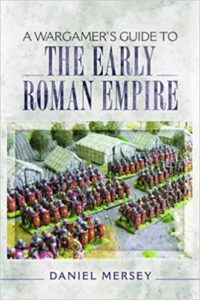 Last month, I picked up a copy of Daniel Mersey’s A Wargamer’s Guide To the Early Roman Empire (AFFILIATE LINK) via Amazon out of pure curiosity.
Last month, I picked up a copy of Daniel Mersey’s A Wargamer’s Guide To the Early Roman Empire (AFFILIATE LINK) via Amazon out of pure curiosity.
Daniel Mersey is well known for creating game books for Osprey Publishing: Dux Bellorum (2012), Lion Rampant (2014), Dragon Rampant (2015), The Men Who Would Be Kings (2016), and A Wargamer’s Guide to 1066 and The Norman Conquest (2017).
A Wargamer’s Guide To The Early Roman Empire was published as a simple guide to the Principate period (27 B.C. to A.D. 284). Over the past few years, the Roman Empire has been a fascination for me. It would be safe to say that I may host an Ancient Roman war game with friends as some point. As a history buff and a gamer, I was interested in seeing how Mersey’s book explains the period to gamers, and how they can incorporate that knowledge into the wargaming hobby. The book is fairly simple to thumb through, as it is not a large book, being only 136 pages, including the index. The sections that list the history, military equipment and tactics, key battles, wargaming the period, scenarios, rules, army building, and further reading are brief. In the Introduction, Mersey states:
“This book helps you to collect and field armies for wargames, and play through an enjoyable, historically plausible battle on your tabletop…It is a wargamer’s guide, rather than a linear military history of the period.”
This is simply a small book to help wargamers get started in playing battles in this time period. Mersey does leave a further reading section with a useful list of academic books for wargamers to read for further research. In the beginning of the book, the readers are givena brief, informative view of the Principate period, outlining the key points of the state of the Roman Empire and her neighbors, such as the military disaster at Teutoburg Forest and Rome’s excursion in Germany, to Marcus Aurelius’ defense of Rome from Germanic invaders in the 160s.
This is followed by a list of civilizations, their armies, tactics, and equipment. All of these features are well researched by the author as he delves into the histories written in the modern day and from ancient sources. So for an example, we will look at the section on the Roman Army. Mersey divides the Roman Army into three troop types, Legionary Infantry, Auxiliary Infantry, and Cavalry. Mersey provides a short history of the structure of the Roman army, followed by a description of the kit that legionnaires, auxiliaries, and cavalrymen would have carried into battle.
The author underlines the tactics used by the Roman Army, with the legions in the middle, having cavalry on both sides for flanking maneuvers, and auxiliaries in front of the legion or beside them (Mersey. 28, 29). Mersey would also highlight the popular tactics used by the infantry, Cuneus (“wedge”), Orbis (“circular”), and Testudo (“tortoise”) (Mersey 30). While the section on the Roman army is much more detailed, the sections on Rome’s enemies are bit shorter, but contain good enough information on what enemy soldiers wore and used in combat.
The book also introduces key battles of the Ancient Roman era that could be played out, along with a chapter of sample battle scenarios. The one that stuck out for me was the Battle of Teutoburg Forest. Apart from being known as a huge defeat for the professional Roman military, I thought about how this battle could be played out.
While I lean more towards 10mm miniatures, having 15mm or 28mm miniatures would work well in playing legionnaires warding off German ambushes, trying to survive as long as possible. The battle lasts three days, and Mersey suggests making each battle one per day, or refight a battle from a specific day.
Mersey also adds a negative modifier to legionnaires due to the thick forests, preventing the Romans from forming special tactical formations. The terrain would add penalties to the Roman units as they will not be able to fight in good order, and would prevent them from knowing when and where the Germans would attack. (Mersey. 50)
This would be great for those playing Roman to see if they could probably rewrite history and make the Battle of Teutoburg a Roman victory. It might not be the most suitable game for those who are new to wargaming, but for more experienced players who would like a challenge.
In a section on scenarios, there are a good many ideas that Mersey had created for smaller and medium scale battles for players to enjoy. The one scenario that is my favorite is the Supply Wagon Massacre, as I believe this would be a great scenario of beginning wargamers to take on. Mersey creates a simple scenario were one player controls a small supply wagon being escorted by both cavalry and heavy infantry, while the other player, mostly cavalry and light infantry, will try to stop the supply wagon to loot. The objective for the escort is to make sure that the wagon makes it from one end of the game table to other (Mersey 103, 104). This would be great for beginners, especially for those who would like to play skirmish games with large miniatures in the 15mm to 28mm range.
Lastly, Mersey gives a list of different companies that create Roman era miniatures and different rule systems, along with his own critique. The charts for the list of companies shows a list of nine factions to play as, Romans 1st/2nd century, Romans 3rd Century, Britons, Caledonians, Dacians, Germans, Palmyrans, Pathrians, and Sassanids. The list goes from 28mm scale all the way down to 6mm scale. The purpose of this chart is to show which company specializes in making certain models at that scale. The author does not give his own critique of each company, this is something that should be left up to the hobbyist. I have written my own article on a blog were I have given my own opinion on about the quality of miniatures from different companies. What one may work for one person may not work well for another.
When it comes to choosing a rules to play Ancient Roman wargames, it really is up to the player what system works for them. Mersey looks at a couple of rules that had been published, from Rick Priestley’s Hail Caesar to the Lord of The Rings Strategy Battle Games. There are many rule systems that are tailored to the time period, while others can be easily modified to fit the game master’s standards.
Mersey looks at rule systems for both large scale battles and for skirmish games. I unfortunately have never played any of these systems, so I can not comment on Mersey’s viewpoints. Players can take his comments to heart and try them out to see how it works out for them. Earlier this year, I was able to play Rick Priestley’s Warlords of Erewhon (2019), and thought the rules were easy to understand, and were perfect for short, skirmish games for Ancient Rome (the book has an army list for Classical Greece). That will be a rule system that will have to review for another time.
In short, this book is what I would consider a starter book for those who want to wargame in the earliest period of Imperial Rome. Mersey’s guide is helpful for those wargamers who may know some or none of Roman-era warfare. It is brief and to the point in helping newcomers get started in creating their armies, where they could find the right miniatures, and the proper rule system for their game. Mersey’s book is well researched and would serve as a gateway for wargamers into Ancient wargaming.
Sources:
Image of product from Amazon.com.
Mersey, Daniel. A Wargamer’s Guide To The Early Roman Empire. ( United Kingdom: Pen & Sword Military, 2017)



